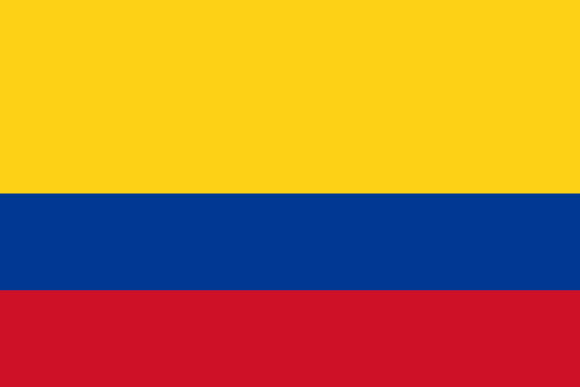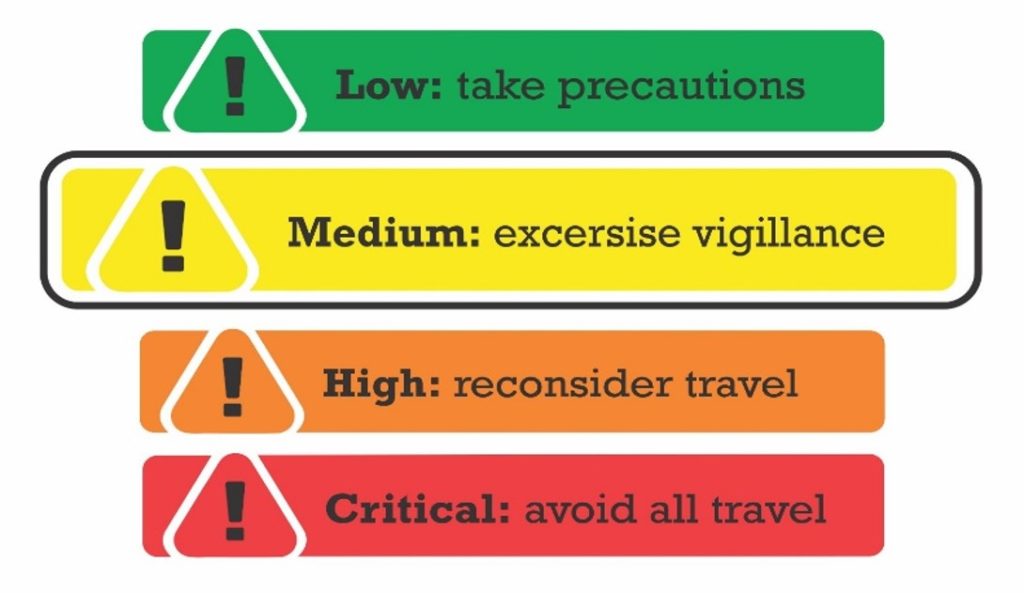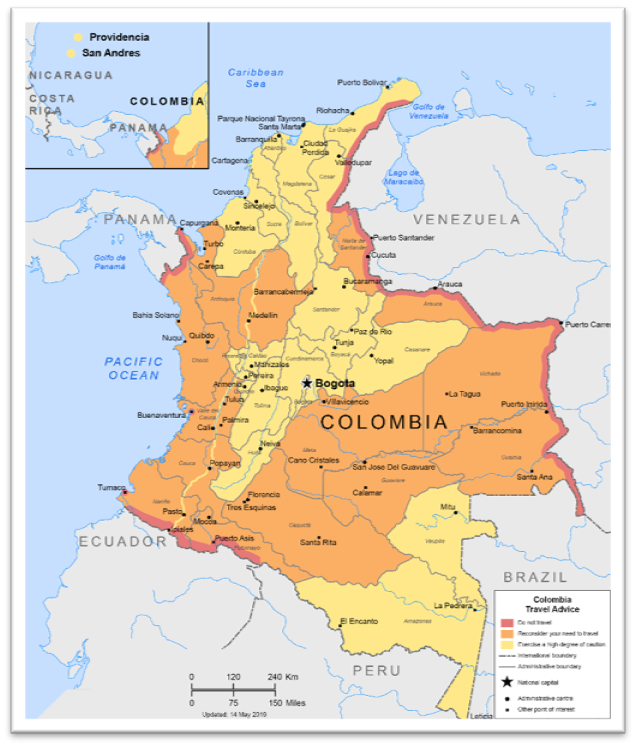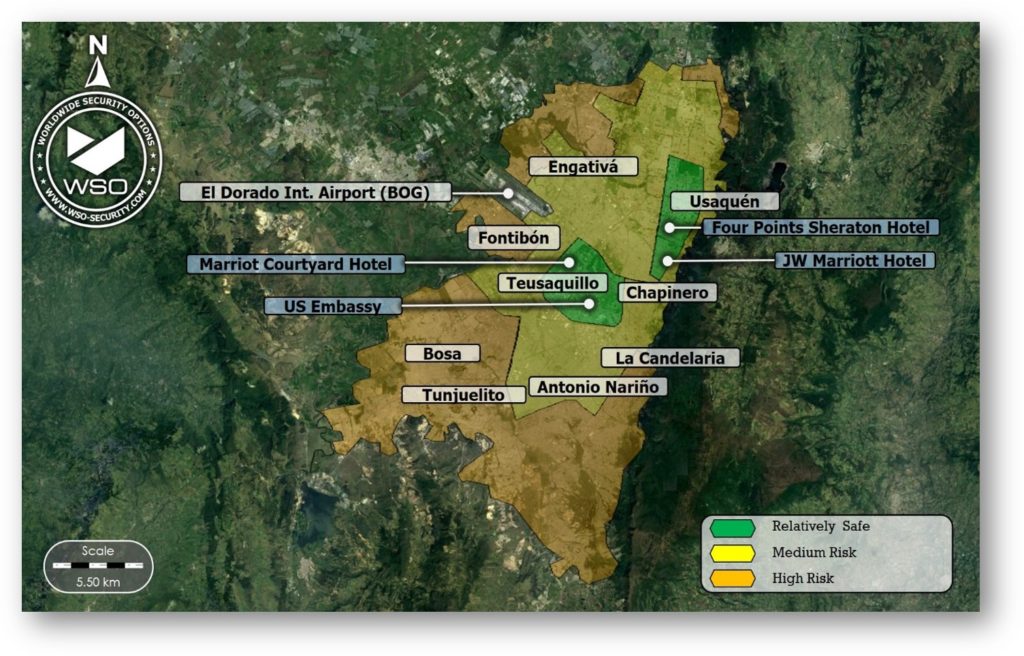| Official Name | Republic of Colombia |
| Official Language: | Spanish |
| Area: | 1,141,748 km2 (440,831 sq mi) |
| Population: | 48,260,000 |
| Time Zone: | UTC−5 |
| Capital City: | Bogotá |
| Height (Bogotá): | 2,640 m (8,660 ft) |
| Currency: | Colombian peso (COP) |
| Main Cities: | Bogotá, Medellín, Cali, Barranquilla |
| Main Port: | Puerto de Buenaventura (Cartagena) |
| Required visa for entry: | Nationals from Australia, Canada, EU countries, the UK, and others DO NOT require visas. Click here for more information concerning visa requirements. |
| Required vaccination for entry: | None |

Main Risks:
Theft, robbery, kidnapping, extortion, rape, drug and human trafficking, fraud, vehicle assault, unruly demonstrations.
Executive Summary
Colombia features intermediate risks chiefly associated with the possibility of suffering armed and unarmed robbery at the hands of common criminals or organized gangs. Security risks increase if itineraries involve road travel through the countryside and/or remote areas. In Bogotá, it is recommended to avoid travel through southern neighborhoods where security risks are higher. Political rallies and events occur regularly in urban areas. It is recommended to avoid the vicinity of any area where demonstrations unfold. Even peaceful ones can rapidly devolve into violence. In case of high-profile travel, we recommend hiring secure transportation or executive protection services, especially if the itinerary requires travel to countryside areas via land routes.

General Risk Level: MEDIUM.
The risk remains stable throughout the country. It is necessary to take or anticipate increased security precautions before traveling to rural zones or neighborhoods flagged as dangerous.

Crime and Security
Similar to what transpires in other Latin American countries, low and medium-level crime represents the main threat to travelers visiting Colombia. The risk of suffering robbery is higher in the largest urban areas, including Bogotá. Although kidnapping rates have considerably decreased in recent years, there is still a distinct risk of suffering such. Criminals are known to hold their victims captive for relatively short periods of time and force them to extract cash from ATMs before being released.
Criminals often resort to fake taxis, taking advantage of their victim’s carelessness to transport them to remote areas beyond police control. Foreigners and locals alike are liable to be targeted.
Visitors should remain cognizant that even the safest areas are liable to witness a crime and violent episodes. Other than low and medium-level crime, drug trafficking and organized crime are clear threats in the country. Armed groups take advantage of Colombia’s adverse geographic conditions to move and store drugs in sparsely populated areas. Jungle areas relatively far from large urban areas are very dangerous and susceptible to be controlled by organized crime. This is especially the case in bordering areas with Panama, Venezuela, and Ecuador. By operating on both sides of a border, transnational groups are able to withdraw from either side depending on the situation and thus avoid probable engagements with security forces.
Note that despite political efforts to pacify the country, the 2016 peace deal between the Revolutionary Armed Forces of Colombia (FARC) and the government is widely considered a failure. FARC elements continue to operate in relatively poor parts of the country. Furthermore, other groups who rejected the peace process outright like the National Liberation Army (ELN) operate in these areas. The ELN is known for blocking national highways and assaulting truck drivers. The group is also noted for carrying out militant attacks against pipelines and oil infrastructure. Political rallies and events occur regularly throughout Colombia, especially in Bogota. During times of heightened political sensitivities, protesters often disrupt traffic along central streets and thoroughfares. Activists at times target vehicles and vandalize public and private property. Violent elements are furthermore known to detonate small improvised explosive devices (IEDs). Police response to such challenges varies but generally involves tear gas and water cannons to disperse unruly demonstrators. It is recommended to avoid the vicinity of any area where demonstrations unfold. Even peaceful ones can rapidly devolve into violence.
Security in Bogota
The safest neighborhoods are located in northeastern parts of the city, in the district of Usaquén. Recommended areas for lodging, travel, and conducting business and transactions are La Castellana, Chico, Chico Norte, Polo Club, and el Retiro. The central district of Teusaquillo es also deemed relatively safe. The most convenient neighborhoods to stay and carry out transactions in this district are Quinta Paredes and Ciudad Salitre Oriental. These areas are perceivably safer than others because they are better protected by security forces and private security agents. They feature embassies, prominent hotels, office towers, and ministerial bodies. In turn, due to security reasons, travel to southern and relatively impoverished neighborhoods should be avoided, particularly beyond the Antonio Nariño district. Although there are no major security problems in the centric and touristic La Candelaria area, please be advised that this district is vulnerable to low-level opportunistic street crime. Visitors are advised to take precautions and exercise vigilance while visiting this area.
It is worth considering that traffic jams in Bogotá are commonplace. Many criminals operate in motorbikes and take advantage of vehicular congestion to assault drivers at a standstill. In addition, while organized crime does not currently pose a major threat to Bogotá, the capital is not completely spared from militant activity. In 2017 an IED was detonated inside a bathroom at the Andino Mall, located in one of the safest areas in the city. Three people were killed in the incident.
The El Dorado International Airport (BOG) is located in the western parts of the city. The trip to/from the airport and the central and relatively safe districts normally takes between 40 and 60 minutes depending on traffic. In any case, due to agenda and security concerns, it is prudent to anticipate travel delays when visiting the city.

Transportation
For security reasons, we do not recommend using public transportation services in Colombia. We advise hiring reputable private transportation services in advance. In the event of high-profile visits, it is best to procure private protection services.
The best option to travel across is the country is to take commercial flights. Although the land routes connecting the main cities are generally in good condition, travel through unpopulated areas with adverse topography entails security risks, especially during dark hours and times of poor visibility. While generally patrolled by security forces, these routes are still vulnerable to organized crime activity. For this reason, if land travel is required, it is advised not to deviate from the main routes, especially avoiding routes removed from central localities.
Therefore, if traveling by land, it is recommended not to deviate from primary thoroughfares or routes, locally called “corredores arteriales”. It is best to avoid secondary routes removed from central localities and which remain in poorer circumstances.
If the itinerary involves travel through relatively remote or sparsely populated areas it is best to plan the route in advance under the supervision of local security professionals. Educated assessments should enable the security contractor to determine the safest route and avoid unilluminated or otherwise dangerous paths.
Health and Sanitary Conditions
Colombia features changing temperatures and travelers may suffer altitude sickness. Travelers should pay attention to meteorological conditions.
While no proof of vaccination is required for entry into the country, it is recommended to have the following vaccines before traveling: yellow fever, tetanus, hepatitis A and B, and typhoid. It is also necessary to wear protection against bugs and avoid leaving body areas uncovered so as to mitigate the risk of suffering mosquito-borne diseases such as dengue, the Chagas disease, and the zika virus. These precautions must be followed while entering remote and jungle areas. The quality of tap water in Colombia is relatively high. However, while staying in remote areas it is always best to resort to sealed bottled water.
It is not advised to travel without international health insurance covering emergency medical evacuation to the country of origin.
Take essential health precautions to mitigate the risk of contracting diseases or viruses. Carry masks in crowded places such as airports and maintain rules of social distance and avoid contact with surfaces of common use in public places. Always carry hand sanitizer.
Tactical Recommendations
Exercise vigilance and situational awareness throughout the duration of the trip to Colombia, especially in urban areas vulnerable to low and medium-level criminal activity. Avoid travel to high and critical risk areas. Avoid all travel to bordering areas with Panama, Venezuela, and Ecuador. In Bogotá, avoid all unnecessary travel to high-risk neighborhoods, especially in southern parts of the city.
We recommend hiring private transportation and executive protection services for high-profile trips, especially if travel through the countryside is required.
Avoid carrying large sums of cash or valuables during the trip. We advise against wearing or carrying items in public that may give the impression of economic affluence and which could attract unwanted attention from criminals.
Avoid traveling through the country in sport or luxurious cars which could attract unwarranted attention from criminals and corrupt police officers.
Do not resist armed robbery attempts. We recommend to always carry a few 20 USD bills or 100 thousand COP bills for duress cases, specifically to appease criminals looking for easy money.
For security reasons avoid travel during night hours, even in urban areas.
We recommend lodging in reputable establishments and hotels with private security. In Bogotá, it is best to stay in centric areas, near or within Usaquén and Teusaquillo.
If private transportation services are unavailable, resort to reputable radio taxi companies, provided they are recommended by the best hotels. Stay alert at all times while traveling by taxi to prevent the driver from taking unnecessary detours or from inflating the fare.
If travel by route through the countryside is required, avoid all detours, especially while traveling through sparsely populated rural or jungle zones. If possible, plan routes and stopovers ahead with the support of a local security contractor.
Avoid the vicinity of every kind of political demonstration or rally in urban areas. Peaceful demonstrations are liable to be infiltrated by violent elements. Take all necessary precautions to mitigate the risk posed by mosquito-borne diseases.
Emergency Contacts
Police: 911
Ambulance: 911
Fire: 911
WSO Global Command Center: +1 956 467 4858 / gcc@wso-security.com
Security advice and assistance over WhatsApp: +593 99 461 1128 / +521 81 1511 3166







